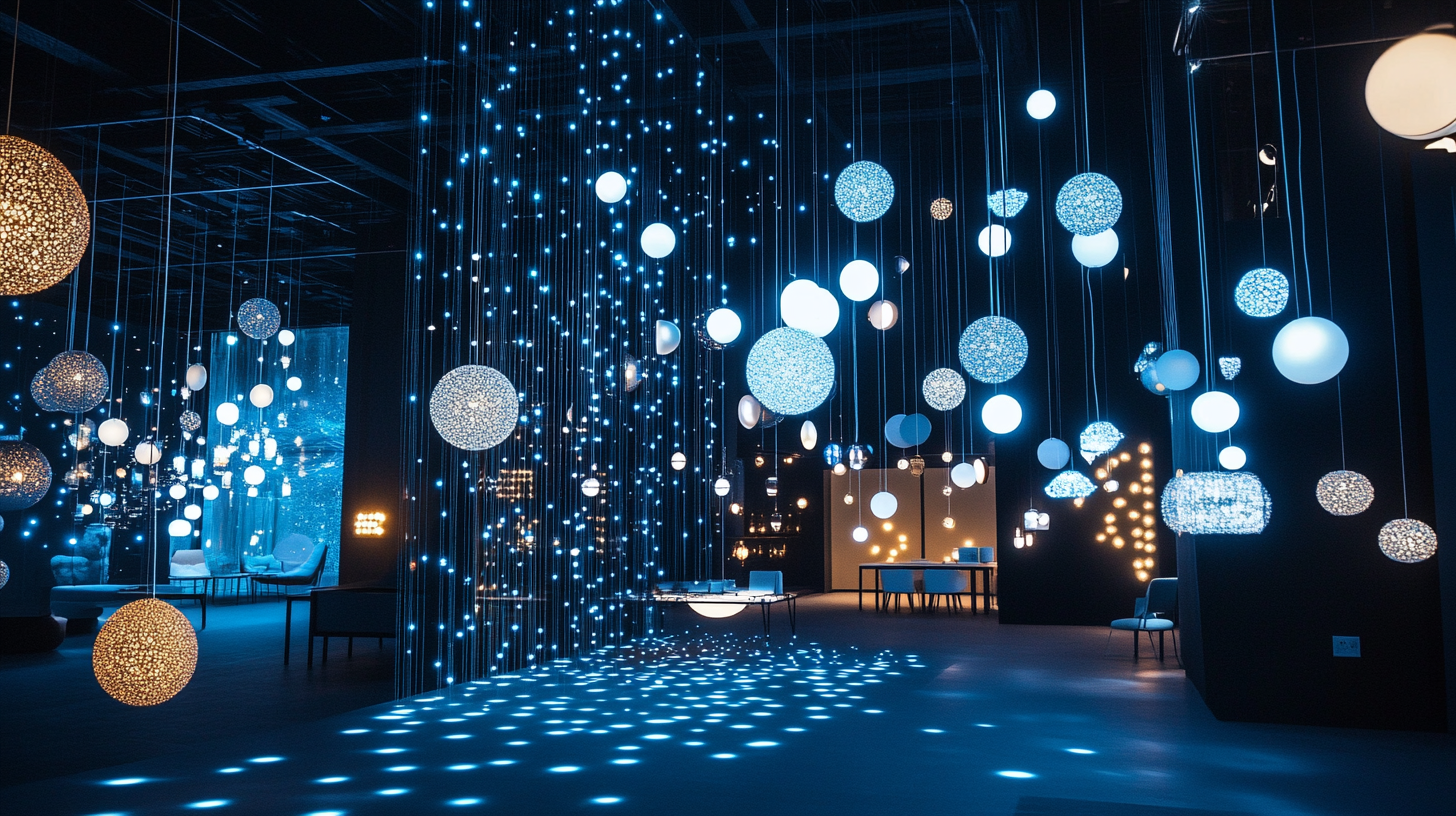Future of Lighting Design Market 2025 Trends and Strategies for Global Buyers
As we look toward 2025, the lighting design market is poised for remarkable evolution, driven by technological advancements and shifting consumer preferences. According to a recent report by Fortune Business Insights, the global lighting market is projected to reach approximately $151.1 billion by 2028, growing at a compound annual growth rate (CAGR) of 5.8% from 2021. This growth reflects not only increasing urbanization and infrastructure development but also a rising awareness of energy efficiency and smart lighting solutions. The demand for innovative lighting design that harmonizes functionality, aesthetics, and sustainability is reshaping the industry landscape, influencing both product offerings and buyer behaviors.
The insights from the Global Lighting Design Trends Report indicate a significant transition towards LED lighting, which represents over 60% of the market share today and is anticipated to dominate in the upcoming years. Additionally, the integration of smart technologies that allow for greater control and customization in lighting design is becoming increasingly essential for global buyers. As we navigate this transformative period, understanding these trends and strategies will be crucial for stakeholders looking to enhance their competitive edge in the dynamic lighting design market.

Emerging Technologies Shaping the Future of Lighting Design
As the lighting design market evolves, emerging technologies are significantly shaping the industry’s future. One notable innovation is OLEDs (Organic Light Emitting Diodes), recognized for their thinness and energy efficiency. According to the CSIRO, OLED technology is positioning itself as a leading contender for revolutionizing lighting design by offering aesthetic and functional advantages over traditional sources. The ability to create sleek, flexible displays allows for novel design possibilities that can cater to modern architectural demands. In tandem with OLEDs, advancements in LED technology are transforming existing infrastructure. For instance, thousands of steel lighting cases in the UK are being upgraded to incorporate the latest LED systems, promoting sustainability through the Carbon Careful initiative. These retrofits extend the life of commercial lighting while significantly reducing energy consumption, aligning with global trends towards greener practices. Additionally, artificial intelligence is emerging as a pivotal force within the lighting design landscape. AI-driven predictive analytics and operational robotics are enhancing efficiency and design precision, ultimately leading to more intelligent lighting solutions that adapt to user needs. As these technologies converge, they unlock opportunities for innovative designs that were previously unimaginable, setting a new standard in the lighting sector. Emerging technologies such as augmented reality (AR) and virtual reality (VR) are also making their mark. These platforms facilitate immersive experiences that enrich the interaction between users and lighting designs, providing a vivid preview of potential applications in real-world settings. As we advance towards 2025, the integration of these technologies will undoubtedly reshape the strategies and offerings within the lighting design market.

Sustainability Trends in Lighting: What Global Buyers Need to Know
As the global lighting market evolves toward 2025, sustainability remains at the forefront of design and consumer preference. The ongoing trend emphasizes eco-friendly lighting solutions that integrate advanced technology, such as smart fixtures that enhance energy efficiency while providing aesthetic appeal. The upcoming HKTDC Hong Kong International Lighting Fair will showcase innovations that reflect this shift, offering insights into how sustainability is driving the demand for intelligent and energy-efficient lighting options.
Global buyers are increasingly interested in materials and designs that prioritize environmental responsibility. The use of sustainable materials, such as recycled plastics and energy-efficient LED technology, is becoming standard practice among leading manufacturers. Events like the Smart Lighting Expo and Salone del Mobile 2025 are set to highlight how industry leaders are embracing sustainability not only as a trend but as a necessary step towards a more responsible future in lighting design.
In addition to environmental consciousness, consumers are leaning towards lighting solutions that offer versatility and smart integration. This transformative phase in the lighting industry is not just about aesthetics but also about creating spaces that respond to the needs of those who inhabit them. As lighting continues to be a crucial element of interior design, global buyers must adapt to these changes to stay competitive in an evolving market focused on sustainability and innovation.

Design Innovations: The Intersection of Aesthetics and Functionality
The lighting design market is undergoing a transformative phase, driven by the interplay of aesthetics and functionality. Recent studies indicate that by 2025, the industry is poised to reach a valuation of approximately $150 billion, expanding at a compound annual growth rate (CAGR) of over 6%. This growth is largely attributed to innovative design approaches that prioritize energy efficiency alongside visual appeal. Designers are increasingly focusing on integrated lighting solutions that adapt to user needs while enhancing the overall ambiance of spaces.
In the pursuit of design innovation, emerging technologies such as smart lighting systems and sustainable materials are becoming pivotal. The incorporation of IoT (Internet of Things) in lighting systems not only improves functionality—allowing users to control lighting remotely—but also fosters energy conservation. For instance, reports suggest that smart lighting can reduce energy consumption by up to 30%, aligning with global sustainability goals.
As global buyers seek to navigate this evolving landscape, they must prioritize partnerships that emphasize cross-disciplinary collaboration. The recent publication from the National Natural Science Foundation highlights the importance of advancing core technologies within the domestic market. By supporting local advancements in lighting technology, stakeholders can contribute to a more robust design industry that meets both aesthetic desires and functional requirements, ultimately shaping the future of lighting design in a global context.

Market Dynamics: Key Players and Competitive Strategies in 2025
The lighting design market is projected to undergo significant transformation by 2025, influenced by evolving consumer preferences and technological advancements. Key players in the industry are embracing innovative strategies to stay competitive, focusing on sustainability and smart technology integration. These strategies not only address the growing demand for energy-efficient solutions but also cater to the increasing consumer awareness surrounding eco-friendly products. As a result, companies are investing heavily in research and development to introduce cutting-edge lighting solutions that blend functionality with aesthetic appeal.
Moreover, collaboration among industry stakeholders is becoming a crucial competitive strategy. Partnerships between lighting manufacturers, designers, and technology firms are on the rise, leading to the creation of smart lighting systems that enhance user experience. These systems utilize IoT (Internet of Things) technology to offer customizable lighting options, automated control, and improved energy management. By leveraging such collaborations, companies can enhance their product offerings and meet the diverse needs of global buyers.
As the market dynamics evolve, understanding consumer behavior will be vital for success. Key players are conducting extensive market research to understand trends and preferences, allowing them to tailor their products accordingly. This customer-centric approach not only fosters brand loyalty but also positions companies to capture a larger share of the market. With the right competitive strategies in place, businesses can navigate the challenges of this rapidly changing landscape and thrive in the future of lighting design.
Consumer Preferences: The Evolution of Smart Lighting Solutions
The landscape of lighting design is undergoing a transformative shift, driven largely by evolving consumer preferences for smart lighting solutions. As technology continues to advance, buyers are increasingly leaning towards systems that offer customization, sustainability, and convenience. The modern consumer seeks not just illumination, but an integrated experience that enhances their living or working environments.
Smart lighting solutions allow users to control their lighting remotely through apps or voice-activated devices, making it easier to create the perfect ambiance for any occasion. Features such as dimming, color temperature adjustments, and programmable schedules are in high demand. Additionally, energy efficiency is a significant factor in decision-making, as consumers are more conscious of their environmental impact and utility costs. For global buyers, understanding these preferences is crucial for crafting products that resonate with the target audience.
Moreover, the integration of smart home technology further elevates the appeal of advanced lighting solutions. Homeowners are increasingly interested in compatibility with existing smart systems, such as security cameras and environmental sensors, creating a more cohesive smart home experience. This trend signals a great opportunity for manufacturers and designers to innovate and cater to the growing market of consumers who value flexibility and connectivity in their lighting choices. As we move towards 2025, keeping an eye on these trends will be essential for anyone involved in the lighting design market.







